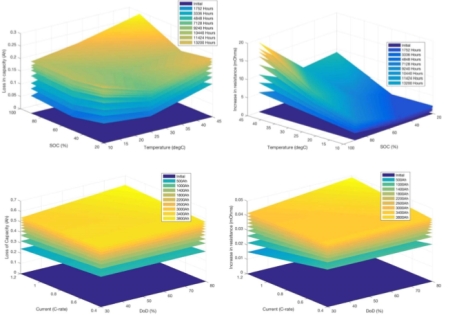There was controversy recently when two different research groups came to two different conclusions about the practicality of using the lithium-ion batteries in electric vehicles as a source of power for the utility grid.
The idea behind vehicle-to-grid (V2G) proposals is that EVs can send the power in their batteries to low-voltage microgrids or buildings, if the need arises. But in the May 2017 issue of the Journal of Power Sources, a group headed up by researcher Matthieu Dubarry presented the results of an experimental study showing that additional cycling to discharge EV batteries to the power grid, even at constant power, degrades battery performance. The following month, in the June 2017 Issue of Energy, another group headed up by Kotub Uddin presented a simulation study claiming that V2G can actually extend the life of lithium-ion batteries in EVs. Interestingly, both studies used similar commercially available 18650-type cells with graphite (GIC)/LiNixCo1−x-yAlyO2 (NCA) negative/positive electrodes.

Rather than argue about the differing results, the two groups got together to see what accounted for the opposing views. They recently published a paper in Energy Policy detailing the results. In a nutshell, they jointly concluded that V2G only works if it takes Li-ion battery degradation into account.
Engineers typically quantify battery degradation in two ways: capacity fade that affects the range of an EV, and power fade resulting from the rise in the internal resistance or impedance of the cell. But it turns out physical degradation modes can be tricky. Some don’t necessarily induce a capacity or power loss initially but can become prominent towards end of battery life. These degradation modes are often associated with a phase of accelerated, nonlinear fading not predictable from capacity and power fade alone. Another problem is that storing cells at progressively higher temperatures and states of charge cause higher capacity and power fade.
Neither of the earlier studies factored in all of the nuances of battery degradation, and that affected their results. For example, Dubarry’s group used a means of accelerated battery aging that eliminated a significant part of the degradation associated with just storing the battery. One of the problems with Uddin’s group was a reliance on outdated degradation models that did not take into account cycling at low or high temperatures as well as constant current/power versus pulse power, fast charging and other factors known to be important for battery life.
But despite the problems with the research, the researchers conclude unintelligent V2G as it exists today is detrimental to the lifetime of an EV battery. This is based on the well-established result that battery degradation is more pronounced with capacity throughput.
On the other hand, a smart-enough grid system could be capable of evading the adverse effects of increased capacity throughput introduced by additional V2G cycling. Such intelligent systems are even able to extend the life of the EV battery beyond the case in which there is no V2G. It also appears that strategies to purely maximize return on investment for the EV owner are not viable because of the resulting battery degradation. The compromise is to set limits on the amount of energy traded, based on prognostics.
Researchers say the simplistic approach adopted by current V2G pilot studies — namely that an EV is discharged and charged without consideration of battery degradation, on-line — is not economically viable because of how additional V2G cycling degrades battery life. However, they think a smart control algorithm with an objective of maximizing battery longevity can reverse this. In such an approach, the control algorithm only allows access to the stored battery energy if there are no adverse effects on battery longevity. So the worst case is that a battery degrades as if there was no V2G.
This approach relies upon the development of accurate battery prognostic models and further advances in understanding the causes, mechanisms and impacts of battery degradation. But researchers admit that establishing the appropriate compensation model will be challenging and necessary for V2G to expand.




Leave a Reply